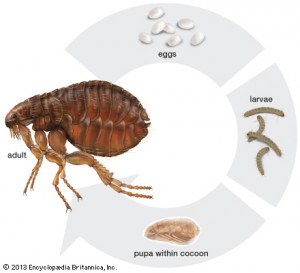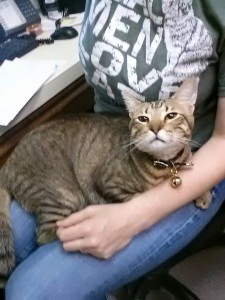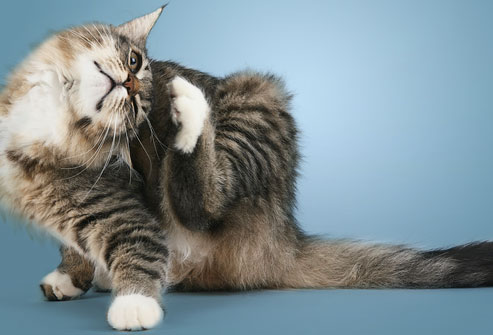Recently, the Cat Connection has received numerous questions regarding fleas and flea treatment. This is no surprise, as DFW’s record-breaking wet spring this year produced an outbreak in flea infestations throughout the metroplex. The rain even jeopardized the feral cat program at Southern Methodist University, and many homes and cats experienced flea issues for the first time. So, with this in mind, here is the Cat Connection’s primer on all things flea-related! Try not to itch too much!
How do I know if my cat has fleas?
Unfortunately, fleas have an uncanny ability to remain undetected until the infestation is severe, especially in cats with long, dense fur, such as Persians, Siberians, Maine Coons and Norwegian Forest Cats. You may notice your cat is scratching a bit more than usual, and she may appear generally uncomfortable. But rather than seeing adult fleas crawling around her fur, you will more than likely find “flea dirt” on your cat or deposited in your home, generally concentrated where your kitty sleeps.

In consistently gross fashion, flea dirt is simply flea excrement and usually collects around the base of your cat’s tail. To check if kitty is suffering, run a fine toothed flea comb backwards through this fur to reveal the skin beneath. Look for dark curly cues deposited at the base of the fur. If you find such suspected specks but are still in denial (we’ve all been there, so no shame), put the offending speck on a piece of white paper towel and add a small drop of water. If the resulting smear is red or reddish brown in color, then your poor kitty has fleas!
Oh no! Fleas! What do I do?
Treating fleas is a frustrating process that requires a multi-step approach. In addition to treating your cat with a veterinarian-approved, cat-specific flea treatment, you must also treat the environment thoroughly, as by the time you are aware of an infestation, fleas will have already laid their eggs in your home. The Cat Connection offers a wide range of products to assist you with this process, including Fleabusters Flea Control Powder, which is a natural compound applied directly to your carpet and floors to kill eggs and larvae, and room foggers. However, as many flea control products contain serious chemicals, it is essential to read and follow directions thoroughly. Unless specified, never apply environmental flea treatments to the animals themselves.
Other ways to rid your home of fleas include vacuuming every day and then disposing of the bag’s contents outside, as well as combing your cat to remove adult fleas. Simply fill a bowl with soapy water and sit kitty down for a calm grooming session with a flea comb. When you snag a flea with the comb, quickly dunk it in the soapy water, thereby drowning the flea and its paranoia-inducing terribleness. One fewer adult flea in your home means fewer eggs, so every one counts!
Be sure to treat all your warm-blooded animals as well. Fleas do not discriminate, and will even snack on humans if no other food source is available.
Cat-specific flea treatment
Whenever treating fleas, be sure to always use flea medicine intended for cats. Never use flea medicine intended for dogs, as this can result in acute illness and even death in cats.
Why are fleas so difficult to get rid of?
By the time you notice kitty is suffering from fleas, it’s likely you have an infestation on your hands. After treating the pets and cleaning the environment, many people are understandably discouraged when the fleas reappear in a few weeks. This is due to the flea’s life cycle, where eggs are deposited in the environment, only to hatch later to eventually re-infest your home and ruin your life. Thus, it is essential to maintain a flea control regime with your pets after the initial infestation has occurred, as well as treat the flea problem consistently for a month. Treatment should target adult fleas through the use of insecticides and flea combing, as well as eggs, larvae and pupa through the use of flea control powder and frequent vacuuming.

What the Cat Connection does when we find fleas on a cat
For the safety of your cats, as well as our own shop cats, the Cat Connection takes every measure possible to keep fleas from calling our store home. To do this, all cats are checked upon arrival for boarding and grooming. If fleas are found on your cat, the Cat Connection will provide a gentle de-flea, which may include combing out the fleas or the administration of a Capstar tablet, which is a safe insecticide used in veterinary medicine to kill external parasites. It does not hurt the cat and is sufficient protection until your kitty can be put on a more comprehensive flea control regime.
The Cat Connection is a flea-free zone, and we believe all cats would prefer to not suffer from these nasty parasites. As such, please understand that we will treat the fleas immediately and in the safest ways possible, but it is up to you to continue a flea-control regime at home. Please respect our grooming and boarding staff if your cat is found to have fleas. Fleas can live in all homes, and a flea infestation is not a reflection on you, your cat or your lifestyle. The employees of the Cat Connection simply want the best for your cat, and constant itching (as well as the potential for secondary complications such as anemia and tapeworms) is not what is best for kitty.

Don’t panic!
Fleas, or any parasite, have the potential to drive humans crazy. While the treatment and control of fleas may take time, it is absolutely possible to win the war and live flea-free. If you fear you may be suffering from the quiet stages of a flea infestation or have declared full-on war, please speak to a friendly salesperson at the Cat Connection. We’ll be sure to help you and kitty stop itching in no time!
Feature image credit: pets.webmd.com


















